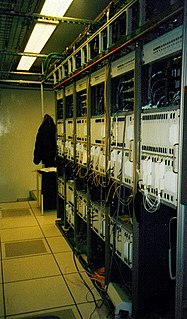
Enhanced Data rates for GSM Evolution (EDGE) also known as Enhanced GPRS (EGPRS), IMT Single Carrier (IMT-SC), or Enhanced Data rates for Global Evolution) is a digital mobile phone technology that allows improved data transmission rates as a backward-compatible extension of GSM. EDGE is considered a pre-3G radio technology and is part of ITU's 3G definition. EDGE was deployed on GSM networks beginning in 2003 – initially by Cingular in the United States.

The Open Systems Interconnection model is a conceptual model that describes the universal standard of communication functions of a telecommunication system or computing system, without any regard to the system's underlying internal technology and specific protocol suites. Therefore, the objective is the interoperability of all diverse communication systems containing standard communication protocols, through the encapsulation and de-encapsulation of data, for all networked communication.

Synchronous optical networking (SONET) and synchronous digital hierarchy (SDH) are standardized protocols that transfer multiple digital bit streams synchronously over optical fiber using lasers or highly coherent light from light-emitting diodes (LEDs). At low transmission rates data can also be transferred via an electrical interface. The method was developed to replace the plesiochronous digital hierarchy (PDH) system for transporting large amounts of telephone calls and data traffic over the same fiber without the problems of synchronization.

X.25 is an ITU-T standard protocol suite for packet-switched data communication in wide area networks (WAN). It was originally defined by the International Telegraph and Telephone Consultative Committee in a series of drafts and finalized in a publication known as The Orange Book in 1976.
In the seven-layer OSI model of computer networking, the physical layer or layer 1 is the first and lowest layer; The layer most closely associated with the physical connection between devices. This layer may be implemented by a PHY chip.

In computer networking, the transport layer is a conceptual division of methods in the layered architecture of protocols in the network stack in the Internet protocol suite and the OSI model. The protocols of this layer provide end-to-end communication services for applications. It provides services such as connection-oriented communication, reliability, flow control, and multiplexing.
The HomePNA Alliance is an incorporated non-profit industry association of companies that develops and standardizes technology for home networking over the existing coaxial cables and telephone wiring within homes, so new wires do not need to be installed.

In IEEE 802 LAN/MAN standards, the medium access control sublayer is the layer that controls the hardware responsible for interaction with the wired, optical or wireless transmission medium. The MAC sublayer and the logical link control (LLC) sublayer together make up the data link layer. Within the data link layer, the LLC provides flow control and multiplexing for the logical link, while the MAC provides flow control and multiplexing for the transmission medium.
Data Over Cable Service Interface Specification (DOCSIS) is an international telecommunications standard that permits the addition of high-bandwidth data transfer to an existing cable television (CATV) system. It is used by many cable television operators to provide cable Internet access over their existing hybrid fiber-coaxial (HFC) infrastructure.
The 3rd Generation Partnership Project (3GPP) is an umbrella term for a number of standards organizations which develop protocols for mobile telecommunications. Its best known work is the development and maintenance of:
The Message Transfer Part (MTP) is part of the Signaling System 7 (SS7) used for communication in Public Switched Telephone Networks. MTP is responsible for reliable, unduplicated and in-sequence transport of SS7 messages between communication partners.
The Telecommunications Management Network is a protocol model defined by ITU-T for managing open systems in a communications network. It is part of the ITU-T Recommendation series M.3000 and is based on the OSI management specifications in ITU-T Recommendation series X.700.
The Open Systems Interconnection protocols are a family of information exchange standards developed jointly by the ISO and the ITU-T. The standardization process began in 1977.
The IEEE Std 1901-2010 is a standard for high speed communication devices via electric power lines, often called broadband over power lines (BPL). The standard uses transmission frequencies below 100 MHz. This standard is usable by all classes of BPL devices, including BPL devices used for the connection to Internet access services as well as BPL devices used within buildings for local area networks, smart energy applications, transportation platforms (vehicle), and other data distribution applications.

G.984, commonly known as GPON, is a standard for passive optical networks (PON) published by the ITU-T. It is commonly used to implement the outermost link to the customer of fibre-to-the-premises (FTTP) services.
G.hn is a specification for home networking with data rates up to 2 Gbit/s and operation over four types of legacy wires: telephone wiring, coaxial cables, power lines and plastic optical fiber. A single G.hn semiconductor device is able to network over any of the supported home wire types. Some benefits of a multi-wire standard are lower equipment development costs and lower deployment costs for service providers.
Ethernet over Coax (EoC) is a family of technologies that supports the transmission of Ethernet frames over coaxial cable.
The I.431/430 Networking standards are recommendations produced by the ITU. They are Layer 1 specifications for ISDN networks, using either an E1 or T1 circuit. The I.431 standard is known as the 'PRI Physical Layer' whereas the I.430 is known as the 'BRI Physical Layer'.
A communication protocol is a system of rules that allows two or more entities of a communications system to transmit information via any kind of variation of a physical quantity. The protocol defines the rules, syntax, semantics and synchronization of communication and possible error recovery methods. Protocols may be implemented by hardware, software, or a combination of both.

Higher Speed PON is a family of ITU-T recommendations for data links, capable of delivering shared Internet access rates up to 50 Gbit/s. Higher Speed PON is the first PON system to use digital signal processing, succeeding both single-channel XGS-PON and multi-channel NG-PON2. It provides upgrade paths for legacy PON generations such as GPON, XG-PON, XGS-PON, and 10G-EPON.